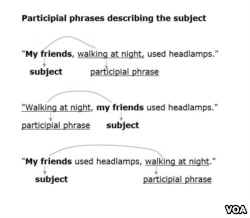
The Music of English Grammar (0:09:32)
From VOA Learning English, this is Everyday Grammar.
“The Rise and Fall of Ziggy Stardust and the Spiders From Mars” is widely considered to be one of the best rock music albums of all time.
The album helped make the British singer David Bowie world-famous.
The songs on Ziggy Stardust tell about a fictional rock star. The music is not only fun to listen to. It can help you better understand the workings of the English language, too.
Consider the song “Starman.” Listen carefully to some of the words:
There’s a starman waiting in the sky
He’d like to come and meet us
But he thinks he’d blow our minds
There’s a starman waiting in the sky
David Bowie is giving us information about how to use participial phrases.
Today, we will explore — much like the larger-than-life personalities in Bowie’s album — a really large space. This area is called movability — or the way English speakers are able to move words or expressions to different places in a sentence.
However, to keep from going too far into outer space, we will study just one kind of movable modifier: the participial phrase.
What are participial phrases?
In an earlier Everyday Grammar program, we talked about present participial phrases. These are groups of words that begin with the present participle, or –ing, form of the verb. Such phrases often act like adjectives in a sentence. They describe or can influence the meaning of other words.
Think back to David Bowie’s song. The first words you heard were:
“There is a starman waiting in the sky…”
In the song lyrics, the participial phrase ‘waiting in the sky’ is acting like an adjective. It has an effect on the noun ‘starman.’
In Bowie’s song, the participial phrase comes at the end of the sentence.
But some participial phrases can move to different places in a sentence — depending on how the sentence is structured.
When participial phrases act as non-restrictive modifiers, they can move around in the sentence. A nonrestrictive modifier does not define a noun; instead, it only adds information or comments on the noun. You can read about these modifiers in another Everyday Grammar program.
When these phrases move to different places, they can come at the beginning, middle, or end of a sentence.
Movable participial phrases
One common adjectival participial phrase comes after the noun it is modifying – often in the middle of a sentence. Here is an example:
“My friends, walking at night, used headlamps.”
The noun phrase, “my friends,” is exact in meaning. The participial phrase “walking at night” acts like an adjective. It gives information about the subject, “my friends.”
If you wanted to move the participial phrase to the beginning of the sentence, you could say, “Walking at night, my friends used headlamps.”
Or if you wanted to move the participial phrase to the end of the sentence, you could say, “My friends used headlamps, walking at night.”
All of these sentences have the same basic meaning.
Moving phrases changes the sound of a sentence
But there is an important difference between all of these sentences: the way they sound.
When reading aloud, the pitch of your voice goes up and down at different places in each sentence. These changes, along with brief stoppages in the sentence, help direct attention to certain words and phrases.
When you change the usual position of a participial phrase, after an important noun, you are drawing more attention to its placement. [1]
Understanding this idea will not only help you understand the music of grammar – the up and down sounds of a voice while speaking English. It will also help you understand how to place emphasis on different ideas.
Many great musicians, poets, and speechwriters use movable phrases when they are writing or speaking, even if they do not consciously think about it.
They want to make sure an important word or idea comes at certain parts of a sentence. They also want to offer a mix in the sentence structures they use.
Moving adjectives, such as participial phrases, to different places in a sentence is one way to meet this objective.
How you can move phrases to highlight certain ideas
So how does this principle work?
In general, the most important information comes at the end of a sentence, says Martha Kolln, a grammar expert.
Important information can come at the beginning of a sentence, too.
So, when the participial phrase ends the sentence “My friends used headlamps, walking at night.” The participial phrase receives great emphasis. When you write or speak this sentence, you are suggesting that “walking at night” is important information.
When you put the participial phrase at the beginning of the sentence, “Walking at night, my friends used headlamps,” it gets some emphasis. You draw the listener or reader’s attention to the information in the participial phrase by its placement – away from the noun it is modifying.
The participial phrase gets the least amount of emphasis when it is in the middle of the sentence: For example, “My friends, walking at night, used headlamps.”
These different grammatical structures are used differently depending on the situation. So, while you might hear some structures at a poetry or book reading, you might not hear them when Americans are talking with one another.
Can you create sentences with movable phrases?
The important points in this discussion are the following: participial phrases often act as adjectives, sometimes move to different places in a sentence and always modify the subject when they are set off by commas.
When you understand these principles, you will be able to write and speak more elegant sentences in English.
Naturally, there are other ways to change the meaning of a sentence. We will explore this in another Everyday Grammar program.
We will leave you today with some homework. Can you move the participial phrase to the beginning or end of this sentence?
The crowd, laughing loudly, stood and clapped.
I’m Jill Robbins.
And I’m John Russell.
John Russell wrote this story for VOA Learning English. George Grow was the editor.
We want to hear from you. Write to us in the Comments Section or on our Facebook page.
[1] Kolln, Martha. Rhetorical Grammar 3rd edition (pgs. 162-169)
Here is another song that uses participial phrases.
_______________________________________________________________
Words in This Story
album – n. a long musical recording on a record, CD, etc., that usually includes a set of songs
fictional – adj. written stories about people and events that are not real
lyrics – n. the words of a song
movability – n. grammar the ability to move to different places in a sentence
modifier – n. a word (such as an adjective or adverb) or phrase that describes another word or group of words
participial phrase – n. a verb phrase that is used to indicate a past or present action and that can also be used like an adjective
nonrestrictive – adj. describing or giving more information about a person or thing but not needed to understand which person or thing is meant
adjectival – adj. a word that describes a noun or a pronoun
headlamp – n. a light worn on the forehead (as of a miner or physician)
pitch – n. the highness or lowness of a sound
certain – adj. particular members of a group
draw – v. to cause (attention) to be given to someone or something
emphasis – n. added force that is given to a word or syllable when speaking
consciously – adv. aware of something (such as a fact or feeling)
principle – n. an idea that forms the basis of something
comma – n. a punctuation mark , that is used to separate words or groups of words in a sentence

